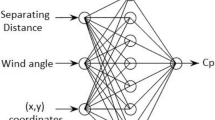Abstract
Most building energy simulations tend to neglect microclimates in building and system design, concentrating instead on building and system efficiency. Energy simulations utilize various outdoor variables from weather data, typically from the average weather record of the nearest weather station that is located in an open field, near airports and parks. The weather data may not accurately represent the physical microclimate of the site, and may therefore reduce the accuracy of simulation results. For this reason, this paper investigates utilizing computational fluid dynamics (CFD) with neural network (NN) model to predict site-specific wind parameters for energy simulation. The CFD simulation is used to find selected samples of site-specific wind conditions. Findings from CFD simulation are used as training data for NN. A trained NN predicts site-specific hourly wind conditions for a typical year. The outcome of the site-specific wind condition from the neural network is used as wind condition input for the energy simulation. The results of energy simulation using typical weather station data and site-specific weather data are compared in this paper, in order to find the possibility of using site-specific weather condition by NN with CFD to yield more realistic and robust ES results.
Similar content being viewed by others
References
Adelard L, Thierry M, Boyer H, Gatina JC (1999). Elaboration of a new tool for weather data sequences generation. In: Proceedings of the 6th International IBPSA Conference (pp. 861–868), Kyoto, Japan.
ASHRAE (2005). ASHRAE Handbook of Fundamentals. Atlanta: American Society of Heating Refrigeration, and Air-Conditioning Engineers.
Beausoleil-Morrison I (2000). The adaptive coupling of heat and airflow modeling within dynamic whole-building simulation. PhD dissertation, University of Strathclyde, UK.
EnergyPlus (2007). Auxiliary EnergyPlus Programs. The board of trustees of the University of Illinois and The regents of the University of California through the Ernest Orlando Lawrence Berkeley National Laboratory. United States Department of Energy.
Engineering Reference (2010). Engineering Reference: The Reference to EnergyPlus Calculations. The board of trustees of the University of Illinois and The regents of the University of California through the Ernest Orlando Lawrence Berkeley National Laboratory. United States Department of Energy.
Chen Q, Van Der Kooi J (1988). ACCURACY—A computer program for combined problems of energy analysis, indoor airflow, and air quality. ASHRAE Transactions, 94(2): 196–214.
Clarke JA, Dempster WM, Negrõ C (1995). The implementation of a computational fluid dynamics algorithms with the ESP-r systems. In: Proceedings of the 4th International IBPSA Conference (pp. 166–175), Madison, USA.
Djunaedy E (2005). External Coupling between Building Energy Simulation and Computational Fluid Dynamics. PhD dissertation, Eindhoven University of Technology.
Evola G, Popov V (2006). Computational analysis of wind driven natural ventilation in buildings. Energy and Buildings, 38: 491–501.
Fluent (2005). FLUENT 6.2 User’s Guide. Lebanon, NH: Fluent inc.
Hagan MT, Demuth HB, Beale MH (1996). Neural Network Design. Boston, MA: PWS Publishing.
Haarhoff J, Mathews EH (2006). A Monte Carlo method for thermal building simulation. Energy and Buildings, 38: 1395–1399.
Hittle DC, Pedersen CO (1981). Periodic and stochastic behavior of weather data. ASHRAE Transactions, 87(2): 173–194.
Hokoi S, Matsumoto M, Ihara T (1990/1991). Statistical time series model of solar radiation and outdoor temperature-identification of seasonal models by Kalman filter. Energy and Buildings, 15: 373–383.
Hong T, Jiang Y (1995). Stochastic weather model for building HVAC systems. Building and Environment, 30: 521–532.
Larry D (2003). Simulation and uncertainty: Weather predictions. In: Malkawi AM, Augenbroe G (eds), Advanced Building Simulation. New York: Spon Press.
Launder BE, Spalding DB (1972). Lectures in Mathematical Models of Turbulence. London: Academic Press.
Malkawi AM, Augenbroe G (2003). Advanced Building Simulation. New York: Spon Press.
MathWorks (2001). Neural Network Toolbox for Use with Matlab. Massachusetts: The MathWorks, Inc.
van Paasn AH, de Jong G (1979). The synthetical reference outdoor climate. Energy and Buildings, 2: 151–161.
Wang L, Wong NH (2009). Coupled simulations for naturally ventilated rooms between building simulation (BS) and computational fluid dynamics (CFD) for better prediction of indoor thermal environment. Building and Environment, 44: 95–112.
Yi YK, Malkawi AM (2008). Site-specific prediction for energy simulation by integrating computational fluid dynamics. Building Simulation, 1: 270–277.
Yoshiad H, Terai T (1992). Modeling of weather data by time series analysis for air-conditioning load calculation. ASHRAE Transactions, 98(1): 328–345.
Yürekli K, Simsek H, Cemek B, Karaman S (2007). Simulating climate variables by using stochastic approach. Building and Environment, 42: 3493–499.
Zhai Z, Chen Q, Klems JH, Haves P (2001). Strategies for coupling energy simulations and computational fluid dynamics programs. In: Proceedings of the 7th International IBPSA conference, Rio de Janeiro, Brazil.
Zhai Z, Chen Q, Haves P, Klems JH (2002). On approaches to couple energy simulation and computational fluid dynamics program. Building and Environment, 37: 857–864.
Zhai Z, Chen Q (2003). Solution characters of iterative coupling between energy simulation and CFD programs. Energy and Buildings, 35: 493–505.
Zhai Z, Chen Q (2006). Sensitivity analysis and application guides for integrated building energy and CFD simulation. Energy and Buildings, 38: 1060–1068.
Author information
Authors and Affiliations
Corresponding author
Rights and permissions
About this article
Cite this article
Yi, Y.K., Malkawi, A.M. Integrating neural network models with computational fluid dynamics (CFD) for site-specific wind condition. Build. Simul. 4, 245–254 (2011). https://doi.org/10.1007/s12273-011-0042-7
Received:
Revised:
Accepted:
Published:
Issue Date:
DOI: https://doi.org/10.1007/s12273-011-0042-7




